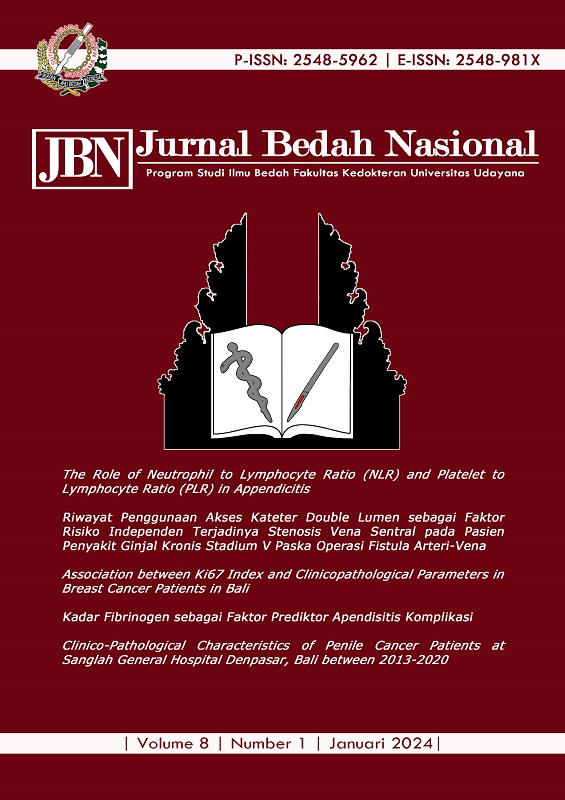Clinico-Pathological Characteristics of Penile Cancer Patients at Sanglah General Hospital Denpasar, Bali between 2013-2020
Abstract
Aim: To know prevalence and clinico-pathological characteristic of penile cancer patients at Sanglah General Hospital Denpasar between 2013 until 2020 or for 7 years periode. Methods: A cross-sectional study to collect retrospective data of penile cancer patients at Sanglah Genaral Hospital from medical records between August 2013 until August 2020. Demographics data consisted of age group and patient’s origin, meanwhile histopathological data included pathological staging, histological subtype, grading, and lymphovascular invasion. Results: 96 penile cancer patients were collected for 7 years. The highest incidence was in 2020. Mean age was 57.60 ± 12.28 years old which dominantly in 60–69 years old groups. Most of patients origin from the rural area. The highest proportions were T3 stage (41,7%), N0 stage (38,5%), M0 stage (94,7%), SCC subtype (89,6%), G2 grade (71,9%), and LVI negative (65,4%). Conclusion: The prevalence of penile cancer patients are fluctuating but tended to increase since 2017. The peak incidence was in 60-69 years old group and from the rural area. Based on TNM staging system, the highest proportion was T3, N0, M0 and G2.
Downloads
References
2. Siegel R, Ma J, Zou Z, et al. Cancer statistics, 2014. CA Cancer J Clin. 2014;64(1):9-29.
3. Digambiro RA, Alferally I, Delyuzar. Hubungan Antara Derajat Histopatologi Karsinoma Penis dengan Tampilan Imunohistokimia HER-2. Majalah Patologi. 2016;25(2):24-28.
4. Tranggono U, Umbas R. Karakteristik dan Terapi Penderita Keganasan Penis di RS Cipto Mangunkusumo dan RS Kanker "Dharmais". Indonesian Journal of Cancer. 2008;2(2):45-50.
5. Prayoga DA, Tranggono U. Evaluasi Klinis dan Manajemen Kanker Penis di Rumah Sakit Sardjito, Yogyakarta. Indonesian Journal of Cancer. 2015;10(1):29-34.
6. Sastrodihardjo B, Duarsa GWK, Partama IPG. Hubungan Ekspresi p-53 dengan Gambaran Kinikopatologi pada Penderita Karsinoma Penis yang Dirawat di Rumah Sakit Sanglah, Denpasar (2001-2005). Indonesian Journal of Cancer. 2009;3(3):85-90.
7. Theddy H, Yudiana IW, Oka AAG. Karakteristik Pasien Karsinoma Penis di Rumah Sakit Sanglah Tahun 2014. MEDICINA. 2018;49(2):48-51.
8. Yudiana IW, Harmaya AK, Oka AAG, Djatisoesanto W. Predictive Factors Of Inguinal Lymph Node Metastasis In Men With Penile Cancer At Sanglah Hospital, Denpasar, Bali. Dermatology Reports. 2019;11(s1):8046.
9. Sugandi S. Referral Pattern of Urological Malignancy in Indonesia. Br J Urol. 1989;63(1):1‐3.
10. Hansen BT, Orumaa M, Lie AK, Brennhovd B, Nygård M. Trends in incidence, mortality and survival of penile squamous cell carcinoma in Norway 1956-2015. Int J Cancer. 2018;142(8):1586-1593.
11. Li K, Sun J, Wei X, et al. Prognostic value of lymphovascular invasion in patients with squamous cell carcinoma of the penis following surgery. BMC Cancer. 2019;19(1):476.

This work is licensed under a Creative Commons Attribution 4.0 International License.
Program Studi Ilmu Bedah Fakultas Kedokteran Universitas Udayana. 
This work is licensed under a Creative Commons Attribution 4.0 International License.






